Abstract
The cause of the initial hyperventilation, which occurs on exposure to O2 at high pressure (o.h.p.), has been investigated by measuring tidal volume (VT), frequency of breathing (f) and hence ventilation (VE) in thirty-six barbiturate-anaesthetized rats, with or without their glossopharyngeal (IX) nerves sectioned, during 30-60 min of exposure to o.h.p. at 4, 6 or 8 atm absolute. In intact rats the rates of rise of VT, f and VE with time during exposure to o.h.p. were smallest at 4 and greatest at 8 atm absolute. In IX-sectioned rats the rates of rise of VT at 4, 6 and 8 atm absolute and of f at 4 atm absolute were similar to those of intact rats. At 6 atm absolute and even more so at 8 atm absolute, however, f decreased. Hence the slope of VE in IX-sectioned compared with intact rats was similar at 4 atm absolute but smaller at 6 and 8 atm absolute. In fact at 8 atm absolute VE remained constant in IX-sectioned rats. Since the slope of VE versus time in intact rats was steeper the greater the pressure and since the removal of carotid bodies in IX-sectioned rats reduced the VE slope at 6 and 8 atm absolute, the stimulus to the hyperventilation induced by o.h.p. cannot be an accumulation of CO2 in the brain resulting from the lack of O2 desaturation of haemoglobin. This theory would predict that VE should be identical at all pressures above 3.5 atm absolute. The findings in the IX-sectioned rats indicate a major contribution of the carotid bodies to the f increase in o.h.p. They may be stimulated by a histotoxic hypoxia induced by early O2 poisoning. Since the VT increase on exposure to o.h.p. was both large and fairly similar in intact and IX-sectioned rats, it is suggested that a large part of the VT increase was caused by stimulation of the central chemoreceptors by lactic acidosis induced by an o.h.p.-induced histotoxic hypoxia of the brain.
Full text
PDF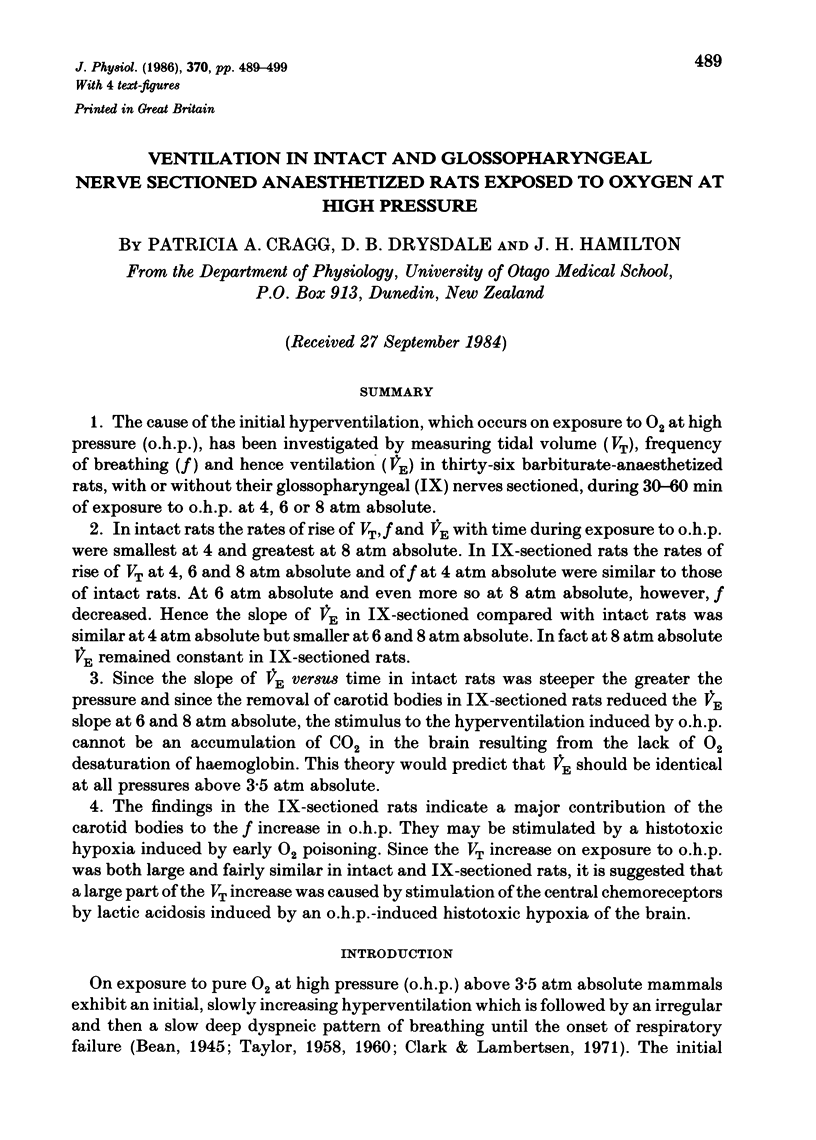
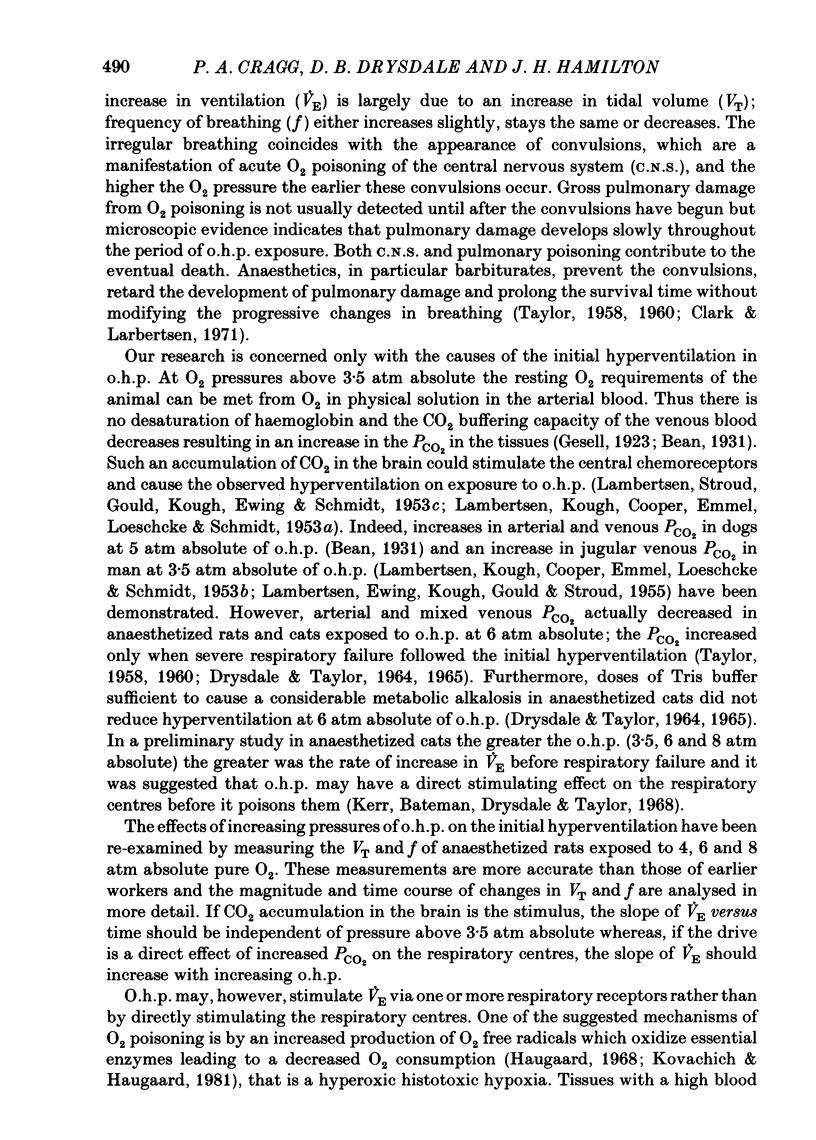
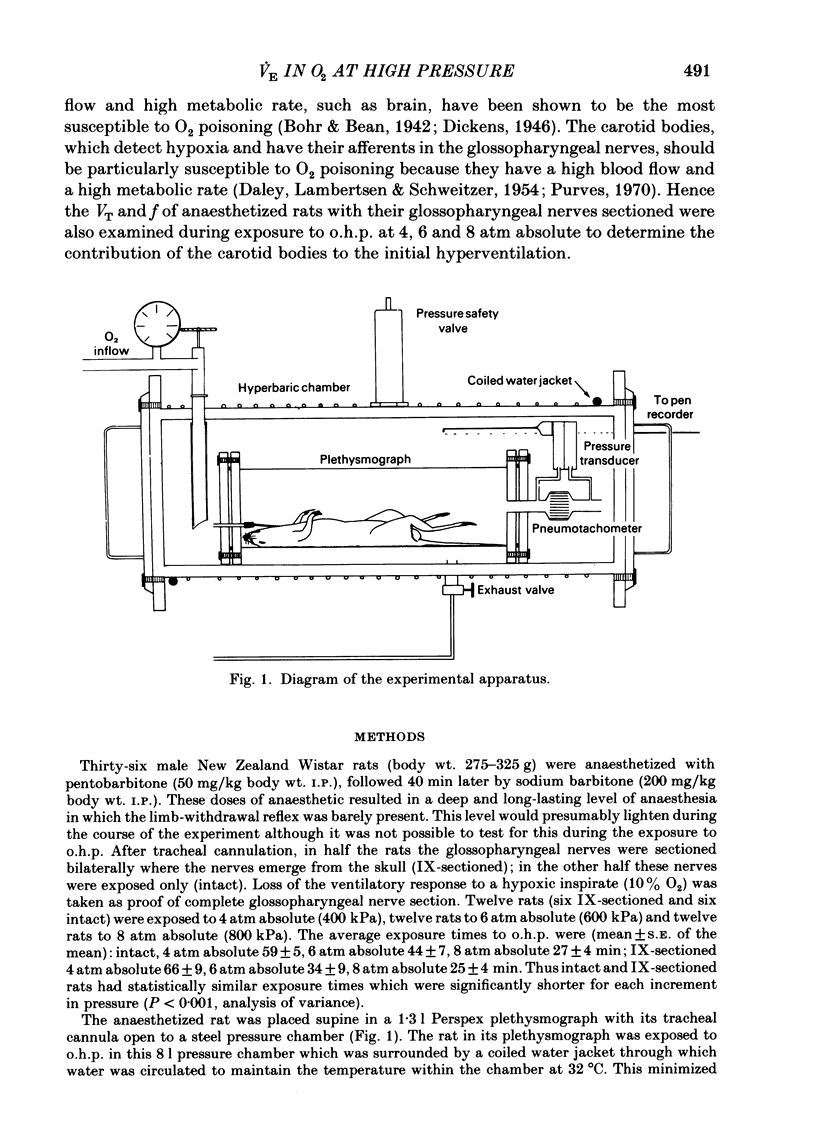
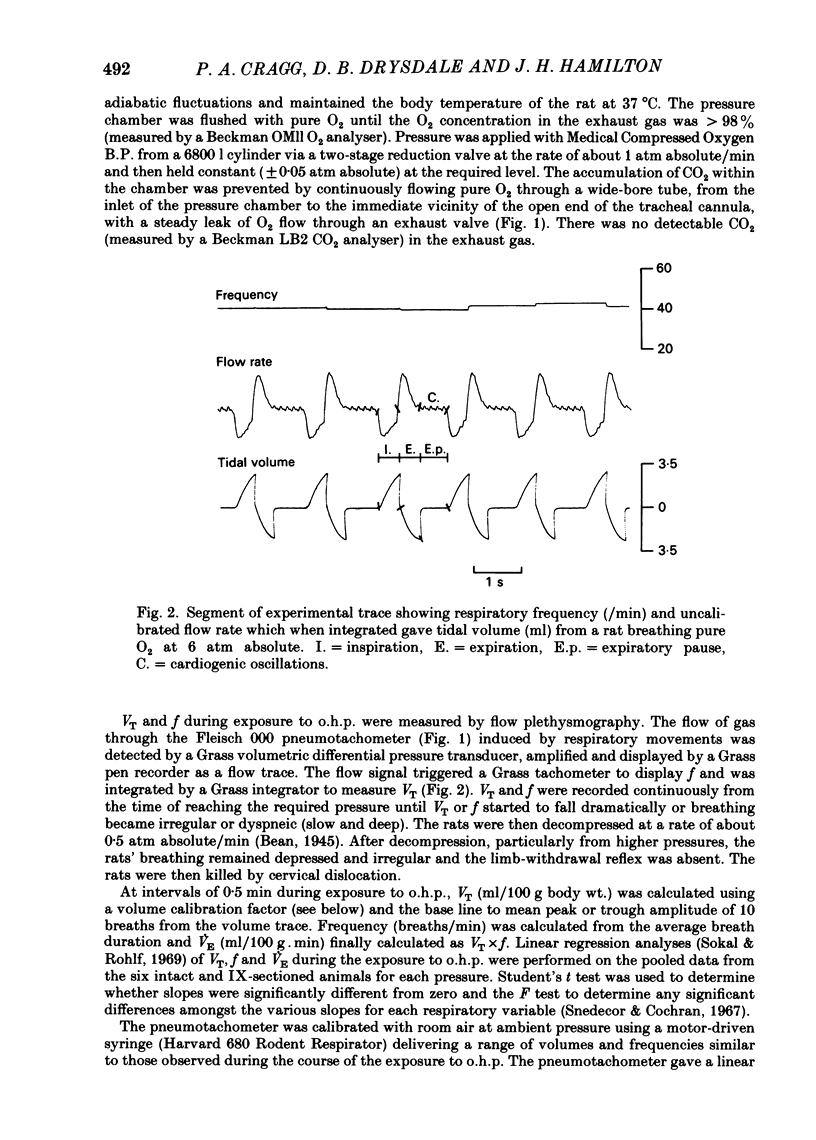
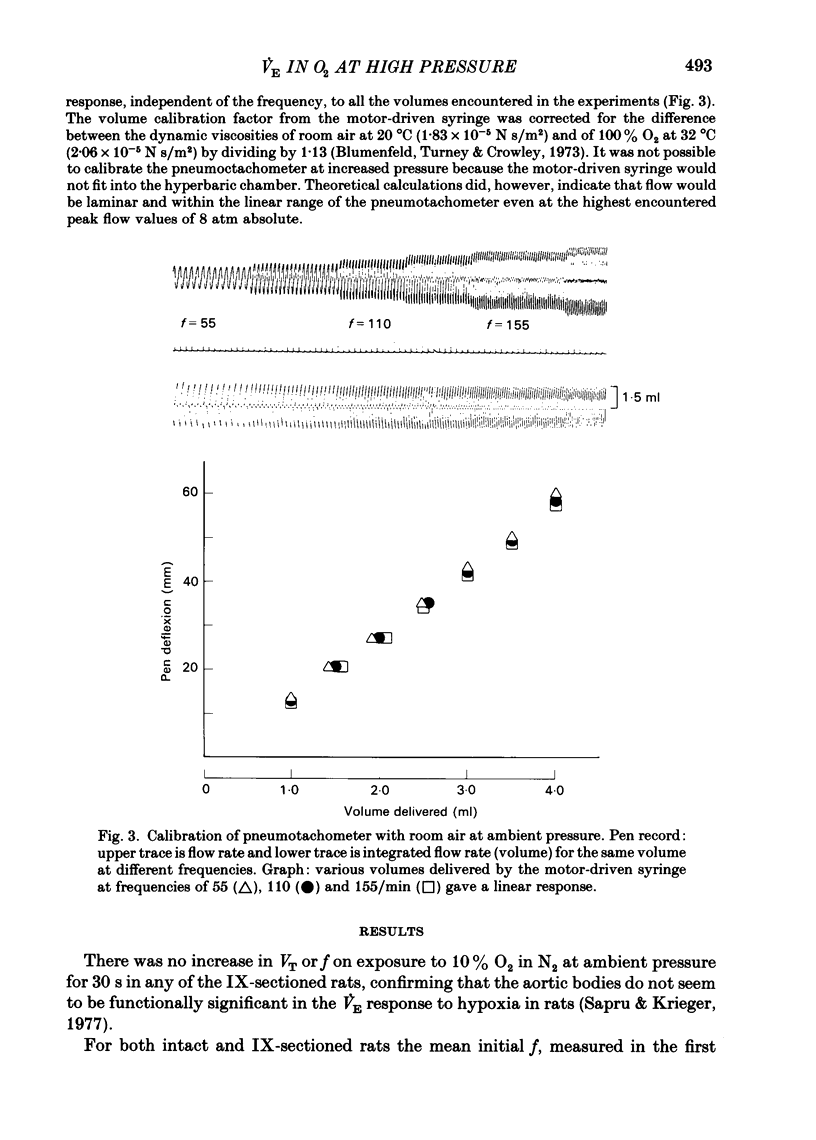
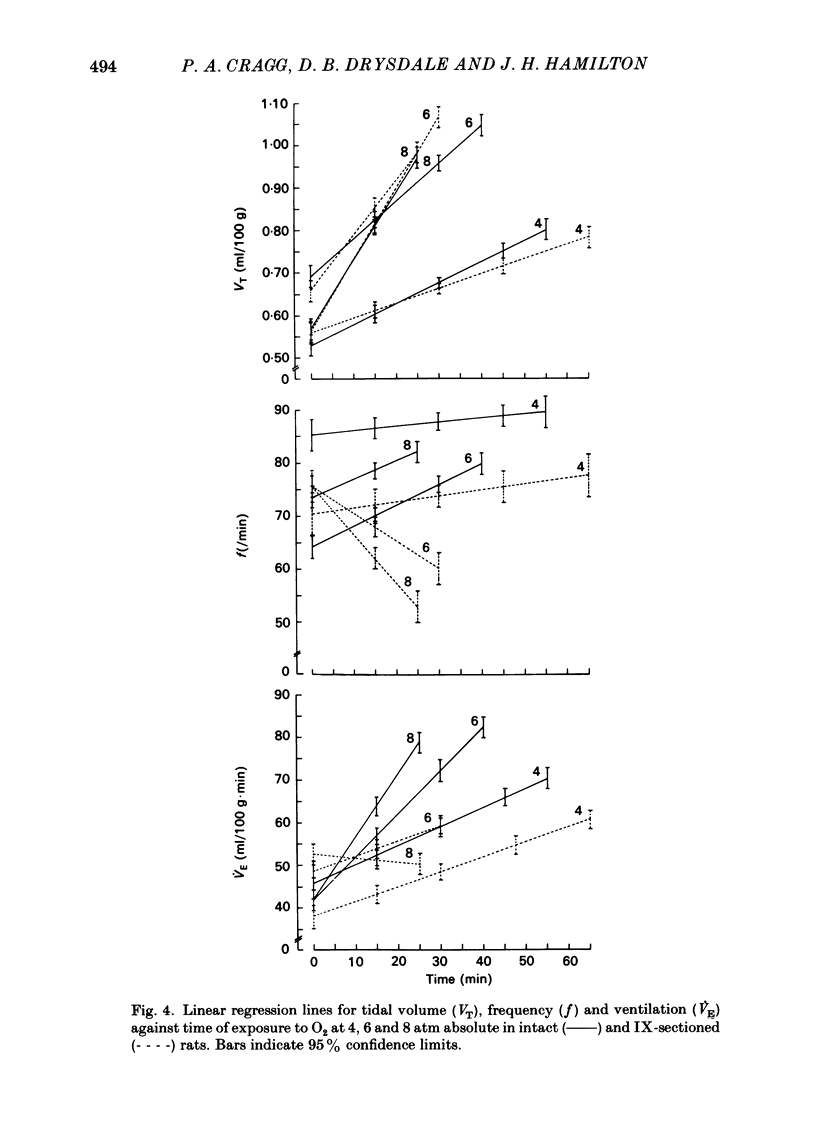
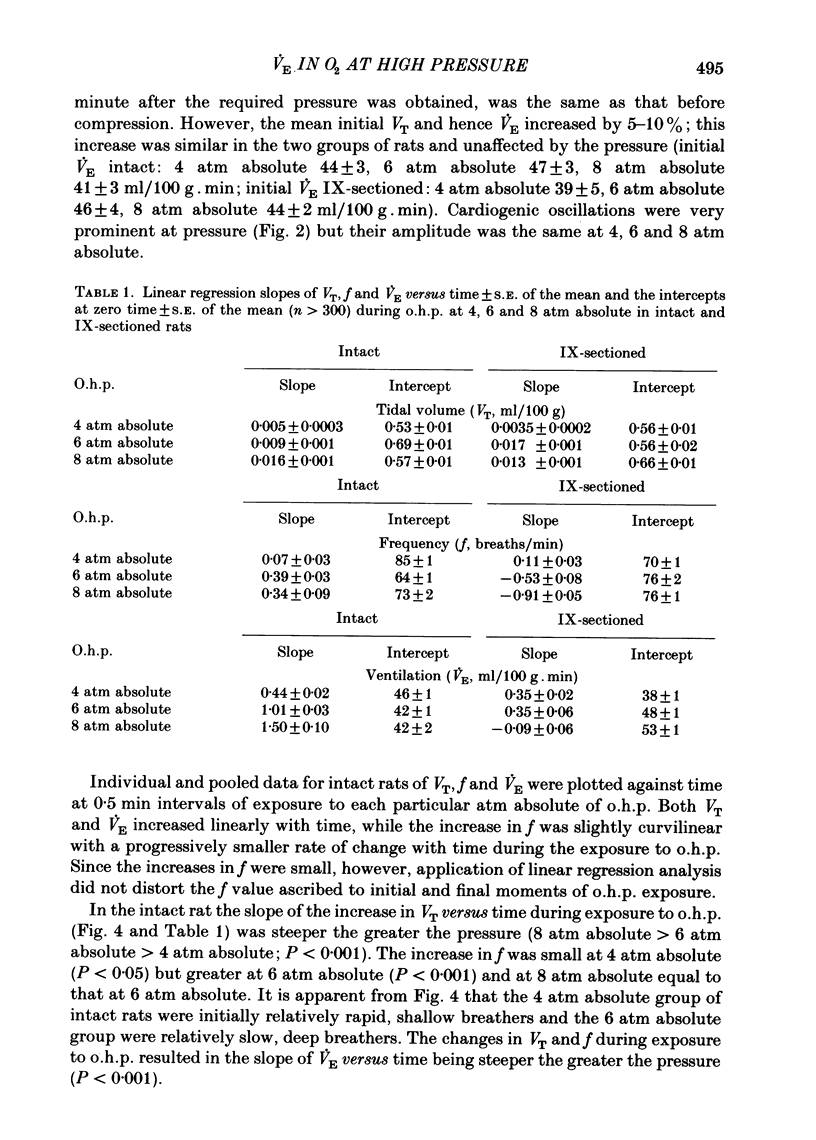
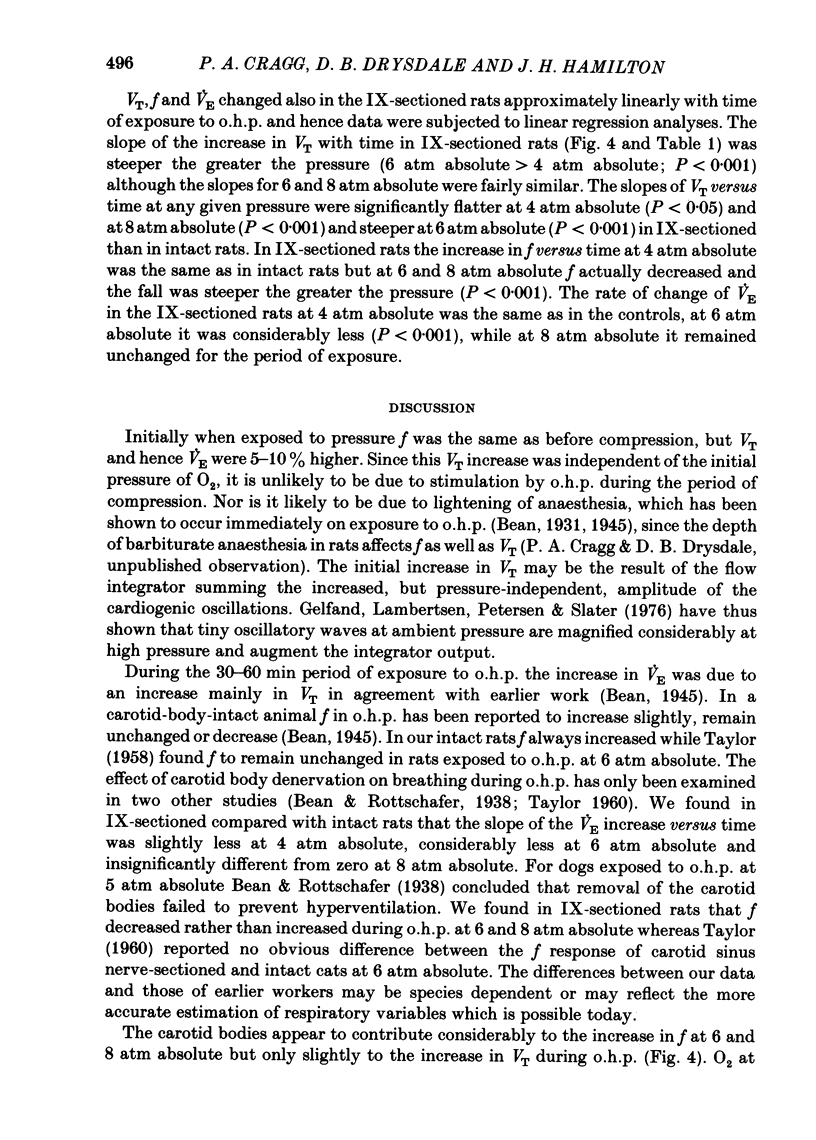
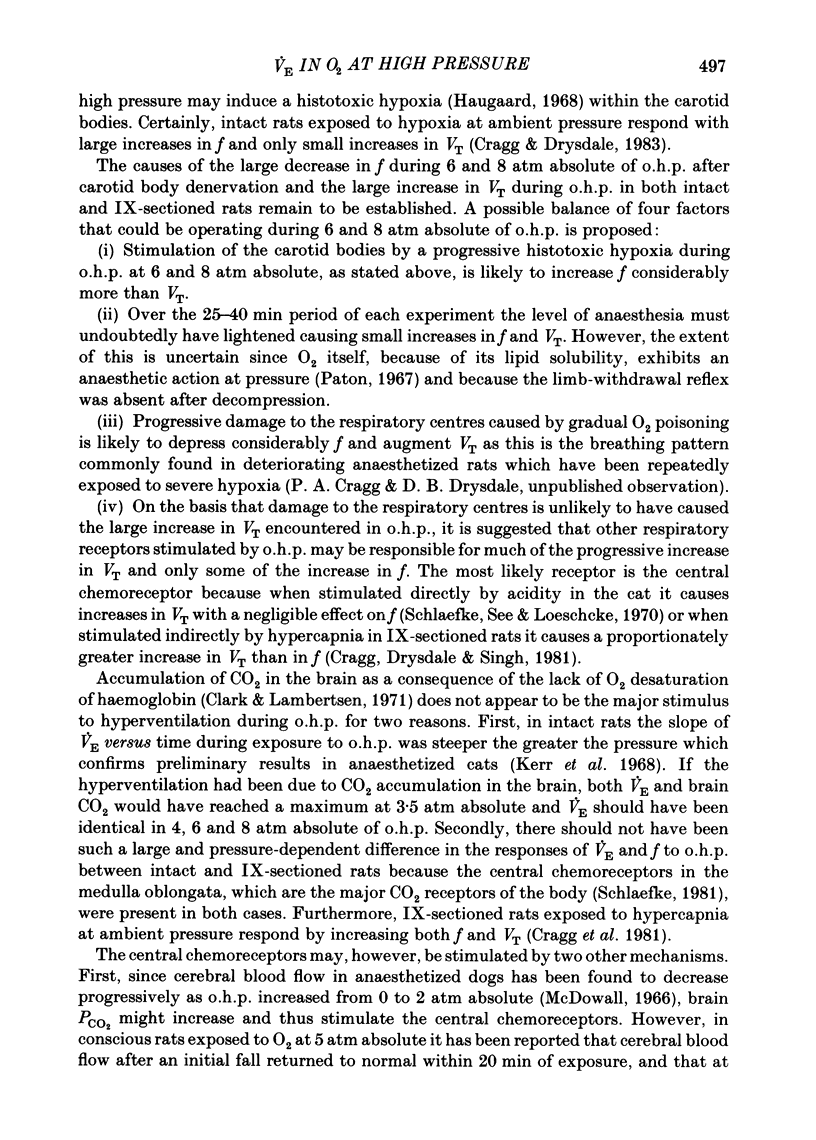
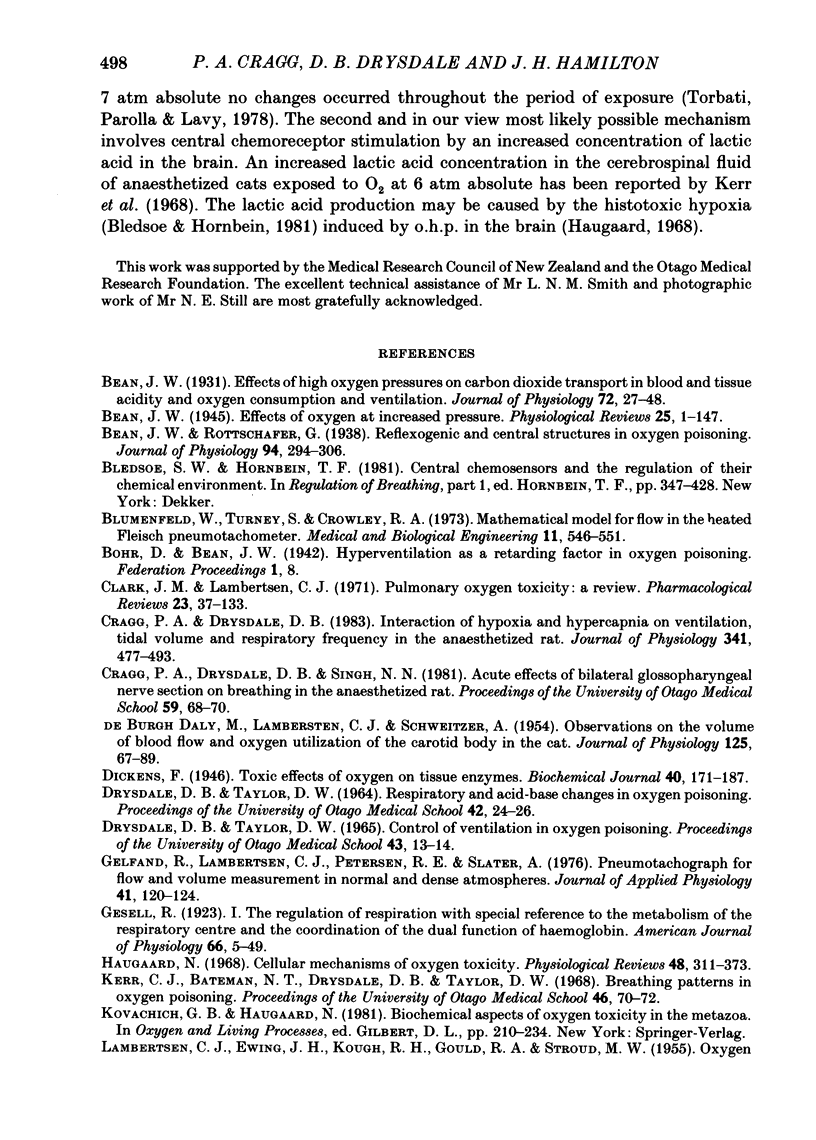
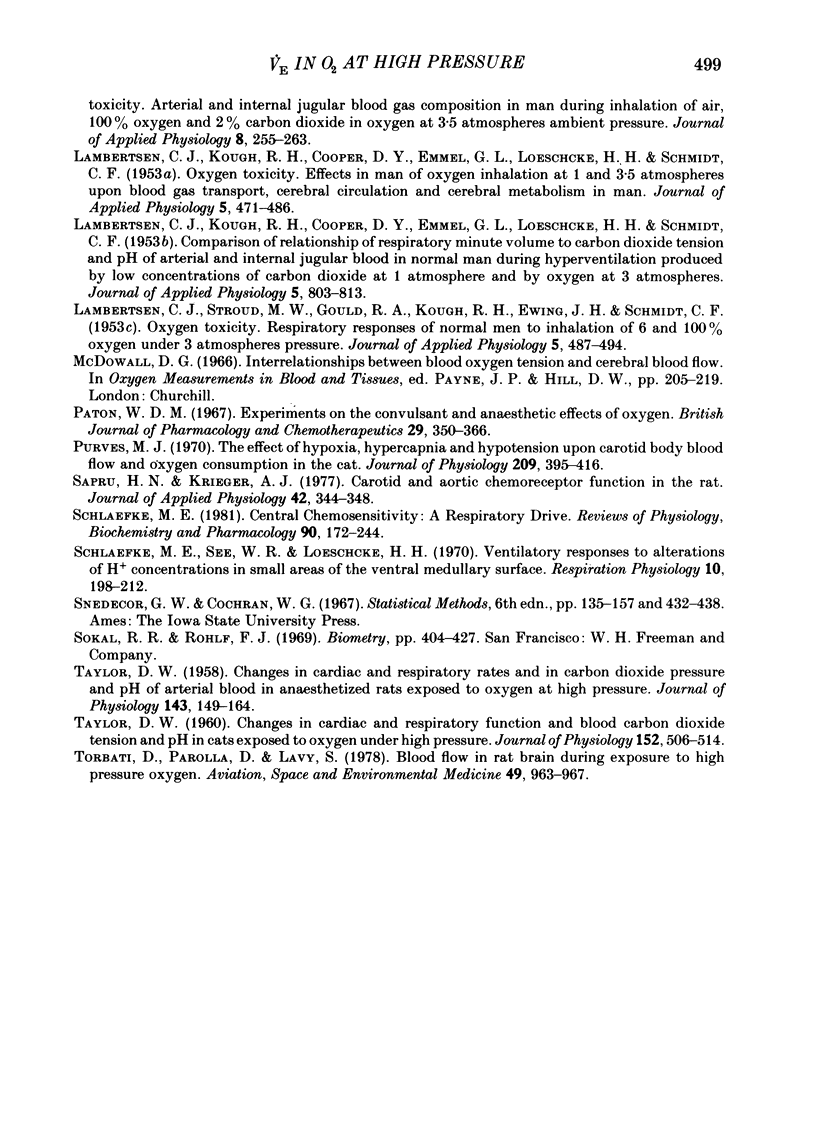
Selected References
These references are in PubMed. This may not be the complete list of references from this article.
- Bean J. W. Effects of high oxygen pressure on carbon dioxide transport, on blood and tissue acidity, and on oxygen consumption and pulmonary ventilation. J Physiol. 1931 Jun 6;72(1):27–48. doi: 10.1113/jphysiol.1931.sp002760. [DOI] [PMC free article] [PubMed] [Google Scholar]
- Bean J. W., Rottschafer G. Reflexogenic and central structures in oxygen poisoning. J Physiol. 1938 Dec 14;94(3):294–306. doi: 10.1113/jphysiol.1938.sp003681. [DOI] [PMC free article] [PubMed] [Google Scholar]
- Blumenfeld W., Turney S., Cowley R. A. Mathematical model for flow in the heated Fleisch pneumotachometer. Med Biol Eng. 1973 Sep;11(5):546–551. doi: 10.1007/BF02477398. [DOI] [PubMed] [Google Scholar]
- Clark J. M., Lambertsen C. J. Pulmonary oxygen toxicity: a review. Pharmacol Rev. 1971 Jun;23(2):37–133. [PubMed] [Google Scholar]
- Cragg P. A., Drysdale D. B. Interaction of hypoxia and hypercapnia on ventilation, tidal volume and respiratory frequency in the anaesthetized rat. J Physiol. 1983 Aug;341:477–493. doi: 10.1113/jphysiol.1983.sp014818. [DOI] [PMC free article] [PubMed] [Google Scholar]
- DE BURGH DALY M., LAMBERTSEN C. J., SCHWEITZER A. Observations on the volume of blood flow and oxygen utilization of the carotid body in the cat. J Physiol. 1954 Jul 28;125(1):67–89. doi: 10.1113/jphysiol.1954.sp005143. [DOI] [PMC free article] [PubMed] [Google Scholar]
- Gelfand R., Lambertsen C. J., Peterson R. E., Slater A. Pneumotachograph for flow and volume measurement in normal and dense atmospheres. J Appl Physiol. 1976 Jul;41(1):120–124. doi: 10.1152/jappl.1976.41.1.120. [DOI] [PubMed] [Google Scholar]
- Haugaard N. Cellular mechanisms of oxygen toxicity. Physiol Rev. 1968 Apr;48(2):311–373. doi: 10.1152/physrev.1968.48.2.311. [DOI] [PubMed] [Google Scholar]
- LAMBERTSEN C. J., DOUGH R. H., COOPER D. Y., EMMEL G. L., LOESCHCKE H. H., SCHMIDT C. F. Oxygen toxicity; effects in man of oxygen inhalation at 1 and 3.5 atmospheres upon blood gas transport, cerebral circulation and cerebral metabolism. J Appl Physiol. 1953 Mar;5(9):471–486. doi: 10.1152/jappl.1953.5.9.471. [DOI] [PubMed] [Google Scholar]
- LAMBERTSEN C. J., EWING J. H., KOUGH R. H., GOULD R., STROUD M. W., 3rd Oxygen toxicity; arterial and internal jugular blood gas composition in man during inhalation of air, 100% O2 and 2% CO2 in O2 at 3.5 atmospheres ambient pressure. J Appl Physiol. 1955 Nov;8(3):255–263. doi: 10.1152/jappl.1955.8.3.255. [DOI] [PubMed] [Google Scholar]
- LAMBERTSEN C. J., STROUD M. W., GOULD R. A., KOUGH R. H., EWING J. H., SCHMIDT C. F. Oxygen toxicity; respiratory responses of normal men to inhalation of 6 and 100 per cent oxygen under 3.5 atmospheres pressure. J Appl Physiol. 1953 Mar;5(9):487–493. doi: 10.1152/jappl.1953.5.9.487. [DOI] [PubMed] [Google Scholar]
- McDowall D. G. Interrelationships between blood oxygen tensions and cerebral blood flow. Int Anesthesiol Clin. 1966 Spring;4(1):205–219. [PubMed] [Google Scholar]
- Paton W. D. Experiments on the convulsant and anaesthetic effects of oxygen. Br J Pharmacol Chemother. 1967 Mar;29(3):350–366. doi: 10.1111/j.1476-5381.1967.tb01967.x. [DOI] [PMC free article] [PubMed] [Google Scholar]
- Purves M. J. The effect of hypoxia, hypercapnia and hypotension upon carotid body blood flow and oxygen consumption in the cat. J Physiol. 1970 Aug;209(2):395–416. doi: 10.1113/jphysiol.1970.sp009171. [DOI] [PMC free article] [PubMed] [Google Scholar]
- Sapru H. N., Krieger A. J. Carotid and aortic chemoreceptor function in the rat. J Appl Physiol Respir Environ Exerc Physiol. 1977 Mar;42(3):344–348. doi: 10.1152/jappl.1977.42.3.344. [DOI] [PubMed] [Google Scholar]
- Schlaefke M. E. Central chemosensitivity: a respiratory drive. Rev Physiol Biochem Pharmacol. 1981;90:171–244. doi: 10.1007/BFb0034080. [DOI] [PubMed] [Google Scholar]
- Schlaefke M. E., See W. R., Loeschcke H. H. Ventilatory response to alterations of H+ ion concentration in small areas of the ventral medullary surface. Respir Physiol. 1970 Sep;10(2):198–212. doi: 10.1016/0034-5687(70)90083-6. [DOI] [PubMed] [Google Scholar]
- TAYLOR D. W. Changes in cardiac and respiratory function, and in blood carbon dioxide pressure and pH, in cats exposed to oxygen under high pressure. J Physiol. 1960 Jul;152:506–514. doi: 10.1113/jphysiol.1960.sp006505. [DOI] [PMC free article] [PubMed] [Google Scholar]
- TAYLOR D. W. Changes in cardiac and respiratory rates, and in carbon dioxide pressure and pH of arterial blood, in anaesthetized rats exposed to oxygen under high pressure. J Physiol. 1958 Aug 29;143(1):149–164. doi: 10.1113/jphysiol.1958.sp006050. [DOI] [PMC free article] [PubMed] [Google Scholar]
- Torbati D., Parolla D., Lavy S. Blood flow in rat brain during exposure to high oxygen pressure. Aviat Space Environ Med. 1978 Aug;49(8):963–967. [PubMed] [Google Scholar]


